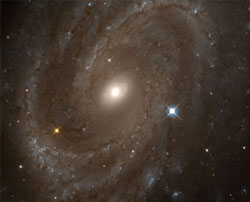Revising Gravity

Newton’s law of gravity is not sacred. The invisible and mysterious material known as dark matter that dominates most galaxies may have its own law of gravity, suggests a team in the 3 October PRL. To resolve some conflicts between theories and observations of real galaxies, they propose that dark matter might be completely oblivious to nearby normal matter and that the two only attract one another at great distances. They say this new gravitational law would fix at least two types of inconsistencies.
Galaxies rotate in ways that signal the presence of invisible dark matter, which is not composed of ordinary particles like protons and neutrons. Dark matter may be the gravitational glue that holds a galaxy together, and it is also thought to influence the Universe as a whole. Cosmologists estimate that 90% of the matter in the Universe may be dark, yet they still know very little about it.
Although standard computer simulations that include dark matter correctly predict galaxy shapes, certain details disagree with observations. For example, the simulations predict that the concentration of dark matter should increase dramatically toward the center of a galaxy, whereas real galaxies show a more gradual increase, based on measurements of their rotation rates. The simulations also predict that many small “satellite” galaxies should form around large galaxies like our own, but the Milky Way has very few of these satellites.
Some theories remove the density discrepancy at the centers of galaxies by proposing that dark matter interacts with itself, by annihilating, scattering, or repelling, when the density reaches a certain level. However, such theories fail on the larger scale: according to observations, galactic clusters do have a large rise in dark matter density at their centers.
Federico Piazza of the University of Milan-Bicocca in Italy and Christian Marinoni of the Marseille Astrophysics Laboratory in France say the discrepancy disappears if normal and dark matter exert a weakened gravitational pull on each other at distances less than a few thousand light-years. At ranges closer than a hundred light-years, the gravitational force would disappear altogether, under their proposal.
The researchers used observations of the rotation of four galaxies to test their theory. When Piazza and Marinoni assumed that gravity acts according to their formula, their calculated dark matter distributions for these galaxies agreed with the conventional simulations.
The theory also explains the lack of dwarf satellite galaxies around the Milky Way. Many small dark matter galaxies might exist nearby, but if they are less than a few thousand light-years in diameter, their weakened gravity may not attract enough normal matter to make them visible to our telescopes.
The modified gravity proposal “contributes a breath of fresh air and healthy irreverence,” to the field, says Riccardo Giovanelli of Cornell University in Ithaca, New York. He says that this new form of the gravitational law is ad hoc but not unreasonable, and that it does seem to fit the data for many galaxies with different masses.
–Kim Krieger
Kim Krieger is a freelance science writer in Norwalk, Connecticut.


